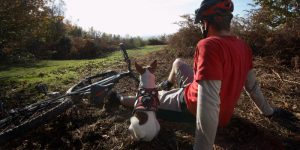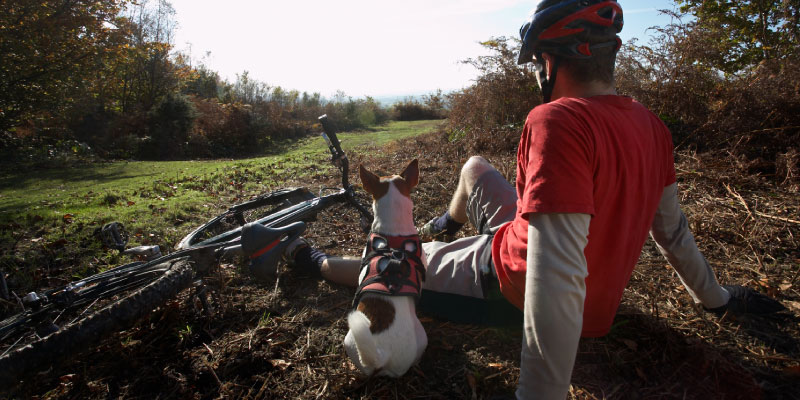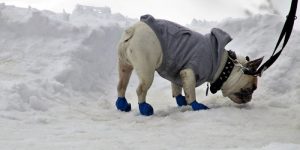Thinking of cycling with your dog? Here’s 5 helpful tips to consider before you jump into a new exercise routine with your pooch.
Getting out and about with your dog is one of the best ways to form a bond. Not only are you and your pup spending quality time together, but you’re socialising your dog with other dogs, and both enjoying the health benefits of exercise.

For those who want to freshen up their routine, biking with your dog is a great place to start. It provides an all-over cardiovascular workout for you, while improving your dog’s endurance and mental health.
As with any new exercise routine, of course, you should speak to your vet. You also need to be aware of the dangers before you hit the road.
What to Consider before you Start:
- Are you healthy enough to do this?
You may need to get out on the bike by yourself to see how far you can go comfortably. - Are you happy to go slow?
The average walker travels at just 3mph, compared to 12 for beginner cyclists, so you’ll have to adjust your speed for your dog. - Is your dog ready to try this new routine?
You may need a general veterinary check-up, plus you should also consider your dog’s age, breed and overall fitness levels. - Do you have a safe area in which to cycle?
You’ll want to avoid roads, and ideally public places that are too crowded, for example playparks during school holidays.
Can you afford to start this new routine? Cycling with your dog will require you to buy a few accessories to keep you and your dog safe. This can really add up if your dog is not running beside you – for example, if you have to buy a dog trailer.
Once you’re confident you can answer all these questions, it’s time to start planning your trip. Before you hit the road, make sure both you and your dog are healthy with these top five tips.
Tip no.1: consider the seasons
Just as you would be careful not to take your dog walking in extreme weather, the same applies to cycling. Keep the following in mind if you’re venturing out in the peak of the seasons.
Do the ground test
Remember, if you touch the ground and it’s hot to the touch, it is too hot for your dog’s feet. This could leave your pup susceptible to dehydration or damaged paws. If you must go out in the height of summer, save it for the early mornings or late evenings. Anywhere between 11am and 3pm, when the sun is at its peak, is a no-no.
Keep your dog cool
Never leave the house without those all-important dog water bottles. If yours is a shaggier dog, you might even want to consider dog cooling vests or go to the groomers and get a buzzcut. Take regular stops and look out for any signs your dog is tired, such as excessive panting or laying down when you stop.
Stay safe in winter
Equally, you should avoid the snowstorms and black ice! Visibility will be reduced considerably during winter, so make sure you have all the appropriate gear to make yourselves seen. A high visibility dog vest is strongly advised, as is a light-up leash and your own fluorescent gear.
Tip 2: bring two leashes
Not all dog leads are made equal. A custom-made bike leash will be able to attach to your bicycle without the danger of you holding it by the handlebars. This will stop your pup from running into your wheels, or causing danger to others.
If you want to disembark and take a look at your surroundings, bring a normal leash too. Make sure your dog is trained in simple commands like responding to its name or “come”. This is especially important if you are checking out a new bike trail for the first time. Woods can have all sorts of hazards from animals to poisonous plants, so keep your pup close by.
Tip 3: plan your route
Just as you would plan your jogging route, or your walking route for you and your pup, you need to make sure your chosen area is safe.
A good dog biking route will be far from main roads, out in the open air, and not too crowded. Try to avoid biking at peak times as you may run into other dog walkers or joggers. You should also check out the area by yourself to spot any potential dangers, like toxic plants or broken glass. If you’re really concerned, consider investing in paw pad protection. Dog boots can keep your dog warm during the winter, and protect them against hazards like glass or a thorn in the paw.
Tip 4: know your dog’s limits
Some dogs are betted suited to go out and about than others. For example, the Border Collie or Australian Shepherd simply love getting out and about, exploring new sights and smells and burning off energy. If yours is a smaller dog, it might be better to consider a special dog basket, backpack or crate that you can attach to the bike.
This is great if you want to get to your favourite walking spot without using the car. Perhaps your pup is only comfortable walking – you can cycle there and pop pooch on the lead before exploring.
For larger dogs, you could also try investing in a dog wagon. These are like sidecars for motorbikes – entirely separate carts that your dog can fit inside and enjoy the ride. Remember not to pedal too fast. You might struggle to do this anyway – dog wagons are designed for pups weighing 20lb and up!
Finally, don’t forget to invest in a comfortable dog harness. This will keep your dog comfortable however you’re choosing to transport him/her, and prevent disasters like running into traffic.
Tip 5: always be prepared for an emergency
When you’re out and about, you never know when things might go awry. Everybody’s definition of an emergency is different – for example, you might just need to carry a puncture kit for a flat tyre. Always keep a charged mobile phone on you, and consider other ‘survival’ tools like a torch and matches if you are far from home.
In addition to a dog water bottle, some doggy protein snacks to give them a little energy along the way and pack a dog first aid kit.
This will largely be the same as a human first aid kit, but it should also include a written guide on how to treat poorly pups. Ask your vet for more information on this. You should also have the number of an emergency vet saved in your phone.
Finally, don’t forget to look after yourself! Wear comfortable trainers, bring snacks/water/energy gels and always wear a helmet. It’s best to get your bike serviced too – the last thing you want is to have brakes fail or split tyres in the middle of the woods.
Start your training plan today
There’s no time like the present. Once you’ve had your check-ups, ease your dog in slowly with a few runs around the block. You’ll both feel the benefits of getting out in the open, while cycling is also a great low impact exercise.
You might just make a few friends along the way – look up local dog walking/cycling groups. Getting out and about with your pooch should be a sociable activity, so your bike is a great place to start.




